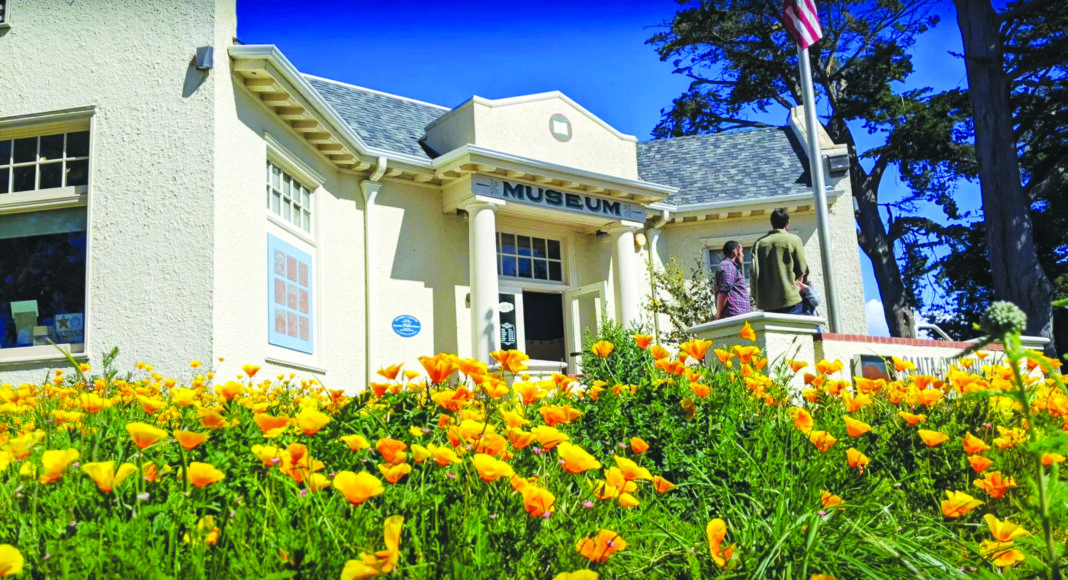After the Covid-19 pandemic struck, the Santa Cruz Museum of Natural History Executive Director Felicia Van Stolk and her colleagues went into overdrive retooling the county’s oldest museum, which first opened in 1905.
Unable to bring guests into its exhibits, the museum applied for Paycheck Protection Program money on the first day that the money became available, and they started overhauling their programs.
“Like everyone else in the spring, we threw everything at the wall to see what stuck, and we got a lot of feedback from parents and teachers. It’s a lot of fun, and it’s been a great iterative, creative process,” Van Stolk says. “It involves a lot of flexibility, which is the key word amid a pandemic and everything that’s happened this year.”
The result has been Museum At Your Side, a collection of hands-on activities, informative articles and engaging videos that connect museum lovers of all ages with nature and science wherever they are. Museum at Your Side is the Natural History Museum’s “Big Idea” for this year’s Santa Cruz Gives holiday giving campaign, which is sponsored by Good Times and runs through Dec. 31.
The museum is part of a long list of Santa Cruz Gives organizations working in both the environmental and education spaces. Also on that list are Bird School Project, Coastal Watershed Council, Ecology Action, Exploring New Horizons, Farm Discovery at Live Earth, Save Our Shores, and Watsonville Wetlands Watch.
Of those, three groups—the Natural History Museum, Ecology Action and Exploring New Horizons—are new to Santa Cruz Gives this year.
As part of Museum at Your Side, the Natural History Museum launched a variety of new informational videos, craft exercises, and geology nights and other online lectures. The arts and crafts were meant for kids but have become very popular among adults, “which is awesome,” Van Stolk says. Another big hit has been a roster of science activities, like a lesson on clouds.
The outdoor world may have particular salience in this time of social isolation.
With the pandemic keeping students inside staring at computer screens for long hours, Exploring New Horizons Executive Director Jacob Sackin says that getting kids to connect with nature can be more impactful than ever.
For 41 years, the outdoor education group Exploring New Horizons has been taking kids into nature with its affordable residential environmental education programs. Sackin says research has shown that exposure to outdoor education correlates with increased motivation to learn, higher levels of learner comprehension, higher self-esteem, better self-control, improved concentration, better conflict resolution and a whole host of other encouraging outcomes. On a personal note, since the pandemic started, Sackin has been noticing that his 4-year-old daughter and his 7-year-old son both do much better whenever they have time in the day to play outdoors.
At work, Sackin has been trying to partner with schools to expand access to Exploring New Horizons’ programs, but he has been running into logistical and funding challenges. The nonprofit’s Big Idea for this year’s Santa Cruz Gives campaign is to meet that increased demand from kids who need to stretch their legs and get some hands-on education after long days of distance learning.
The overarching aim, he says, is to make outdoor education a regular year-round thing, not a special occasion.
“That’s always been the goal—to not have outdoor education just be one camp in the sixth grade that gets talked about for the rest of their lives, because that’s what happens right now. The goal is to embed it,” he says.
Meanwhile, the environmental nonprofit Ecology Action is working to expand ways for kids to get around sustainably and safely.
The group is raising money for its BikeSmart and WalkSmart trainings. Experienced cyclists may lose sight of how challenging it can be to learn those initial elements of bike safety, says Kirsten Liske, Ecology Action’s vice president of community programs.
“If you know how to ride a bike, you forget how hard it is to look over your shoulder or take one hand off the handlebar to make a hand signal,” she says.
Since 2004, Ecology Action has served 46,000 students with its BikeSmart and WalkSmart trainings. Liske believes most Santa Cruzans don’t think of Ecology Action as needing philanthropy, because the group hasn’t done much of it over years. But donors can help support programs where grant support can’t fill in all the gaps. That helps Ecology Action leverage those grants and have a bigger impact.
Teaching children how to get around is as important as ever. It’s been an adjustment teaching all the tricks remotely video on video conferencing. But the trainers have adjusted, and so have the kids.
“They went for it and they’re working on making it even better. We had a few days of wallowing of despair in the beginning, and we started working on how to improve it,” Liske says. “Big kudos to the schools for saying ‘Yes, we’ll continue to make this work!’ It couldn’t happen without the teachers.”
For more information and to donate to any of the 40 nonprofits participating in Santa Cruz Gives, visit santacruzgives.org by Dec. 31.













